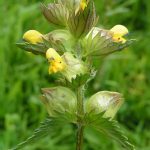 A modified and specialized leaf in the inflorescence, standing below partial peduncles, pedicels or flowers.
A modified and specialized leaf in the inflorescence, standing below partial peduncles, pedicels or flowers.
Any more or less reduced or modified leaf associated with a flower or an inflorescence that is not part of the flower itself.
A leaf-like structure, usually different in form from the normal leaves, associated with the inflorescence.
Modified leaf; some bracts growing near a flower may be more showy than the flower itself (e.g., Poinsettia, where the red “flowers” are actually bracts).
A structure occurring below the petals and sepals of a flower. Bracts are usually small and leaflike, but on some species they are colorful and showy (such as in the ornamental poinsettia).
A leaf situated at the base of a flower or its stalk. Ordinarily bracts are smaller than foliage leaves but are occasionally large and showy, simulating petals.
Reduced or modified leaflets that are usually associated with flowers or an inflorescence, generally subtending or beneath the floral parts.
A modified leaf having flower or an inflorescence in its axis.
One of the leaflike structures of a grouping or arrangement of flowers (inflorescence).
A leaf much reduced in size, particularly if it is associated with a flower or inflorescence.
A small leaf or scale of the axil from which some other part of the plant grows.
A small to large leaflike structure, usually just below a flower or inflorescence. Bracts can range from very small, green, and inconspicuous, like those in the inflorescences of some Acanthaceae, to large and colorful, such as those of Heliconia. The lower bracts of some Heliconia species may develop a leaf blade at the tip.
Scale or sheath-like structure corresponding to a leaf or a flower but without a blade. Bracts can be large and colorful, like the red bracts in Poinsettia.
A modified leaf in the inflorescence, standing below peduncles and pedicels of flowers.
A leaf-like structure, usually green, immediately below a flower and located where the flower-stalk joins the stem. In Umbel lifers (Carrot family), used for the whorl of small leaves at the base of a main umbel.
A leaf-like organ, usually associated with a flower or cluster of flowers, but not part of the flower itself. Bracts are smaller and a different shape to ordinary leaves, as in roses; or they may be brightly colored and resemble petals, as in bougainvilleas and poinsettias.
A modified leaf associated with a flower or group of flowers, usually differing in size, shape or color from a normal foliage leaf. In many plants the bracts are the showiest part of the ‘flower’, for example, in poinsettias.
A small leaf or scale like structure from the axil of which a flower or flower cluster often arises.
A small leaf, often modified, which forms either on the flower stalk or as part of the flower head below the calyx. It bears a flower in its axil.
